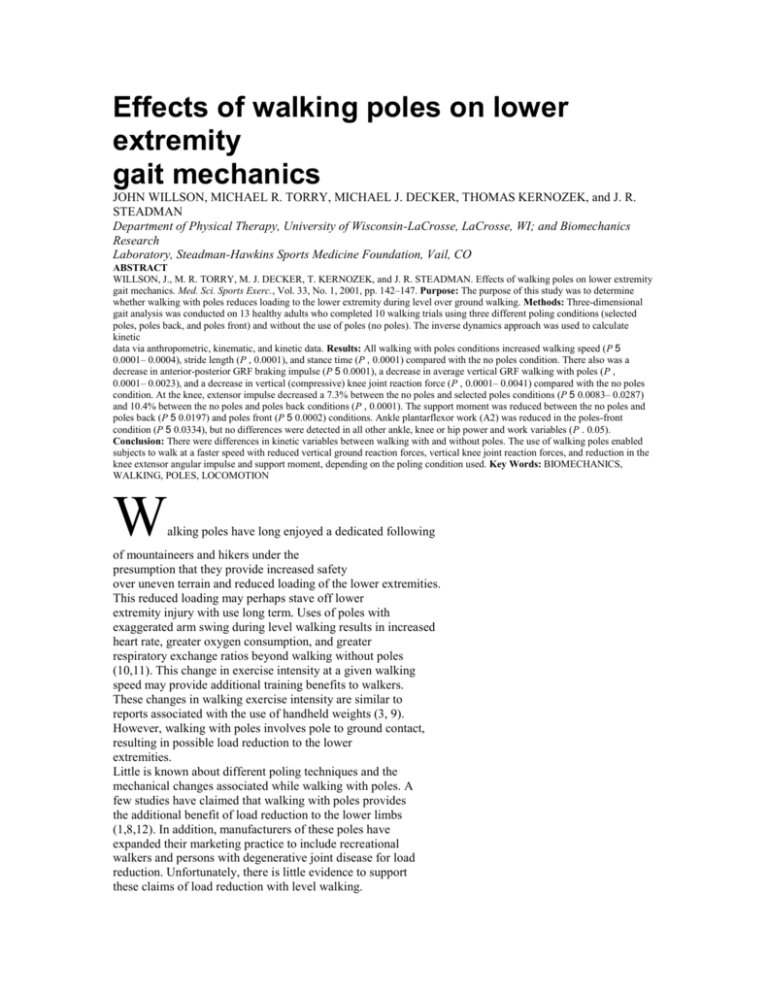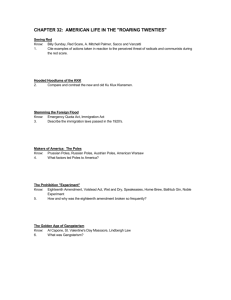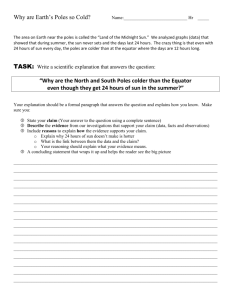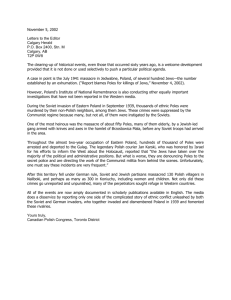Effects of walking poles on lower extremity
advertisement

Effects of walking poles on lower extremity gait mechanics JOHN WILLSON, MICHAEL R. TORRY, MICHAEL J. DECKER, THOMAS KERNOZEK, and J. R. STEADMAN Department of Physical Therapy, University of Wisconsin-LaCrosse, LaCrosse, WI; and Biomechanics Research Laboratory, Steadman-Hawkins Sports Medicine Foundation, Vail, CO ABSTRACT WILLSON, J., M. R. TORRY, M. J. DECKER, T. KERNOZEK, and J. R. STEADMAN. Effects of walking poles on lower extremity gait mechanics. Med. Sci. Sports Exerc., Vol. 33, No. 1, 2001, pp. 142–147. Purpose: The purpose of this study was to determine whether walking with poles reduces loading to the lower extremity during level over ground walking. Methods: Three-dimensional gait analysis was conducted on 13 healthy adults who completed 10 walking trials using three different poling conditions (selected poles, poles back, and poles front) and without the use of poles (no poles). The inverse dynamics approach was used to calculate kinetic data via anthropometric, kinematic, and kinetic data. Results: All walking with poles conditions increased walking speed (P 5 0.0001– 0.0004), stride length (P , 0.0001), and stance time (P , 0.0001) compared with the no poles condition. There also was a decrease in anterior-posterior GRF braking impulse (P 5 0.0001), a decrease in average vertical GRF walking with poles (P , 0.0001– 0.0023), and a decrease in vertical (compressive) knee joint reaction force (P , 0.0001– 0.0041) compared with the no poles condition. At the knee, extensor impulse decreased a 7.3% between the no poles and selected poles conditions (P 5 0.0083– 0.0287) and 10.4% between the no poles and poles back conditions (P , 0.0001). The support moment was reduced between the no poles and poles back (P 5 0.0197) and poles front (P 5 0.0002) conditions. Ankle plantarflexor work (A2) was reduced in the poles-front condition (P 5 0.0334), but no differences were detected in all other ankle, knee or hip power and work variables (P . 0.05). Conclusion: There were differences in kinetic variables between walking with and without poles. The use of walking poles enabled subjects to walk at a faster speed with reduced vertical ground reaction forces, vertical knee joint reaction forces, and reduction in the knee extensor angular impulse and support moment, depending on the poling condition used. Key Words: BIOMECHANICS, WALKING, POLES, LOCOMOTION W alking poles have long enjoyed a dedicated following of mountaineers and hikers under the presumption that they provide increased safety over uneven terrain and reduced loading of the lower extremities. This reduced loading may perhaps stave off lower extremity injury with use long term. Uses of poles with exaggerated arm swing during level walking results in increased heart rate, greater oxygen consumption, and greater respiratory exchange ratios beyond walking without poles (10,11). This change in exercise intensity at a given walking speed may provide additional training benefits to walkers. These changes in walking exercise intensity are similar to reports associated with the use of handheld weights (3, 9). However, walking with poles involves pole to ground contact, resulting in possible load reduction to the lower extremities. Little is known about different poling techniques and the mechanical changes associated while walking with poles. A few studies have claimed that walking with poles provides the additional benefit of load reduction to the lower limbs (1,8,12). In addition, manufacturers of these poles have expanded their marketing practice to include recreational walkers and persons with degenerative joint disease for load reduction. Unfortunately, there is little evidence to support these claims of load reduction with level walking. The purpose of this study was to analyze the effects of walking with poles on the gait mechanics of healthy subjects. It was hypothesized that the use of walking poles would significantly reduce loading on the knee joint as measured by the reduction in the impulse of the vertical ground reaction force and vertical (compressive) knee joint reaction force during single limb support of the gait cycle. Furthermore, specific poling techniques were investigated to determine whether different poling strategies offer greater benefits over techniques recommended by manufacturers. The results of this study will add to our knowledge of mechanical changes in the lower extremity with pole walking. MATERIALS AND METHODS Subjects. Thirteen healthy subjects (8 male; 5 female) volunteered as the test group (mean age 5 29.5 1 6 5.1 yr, mean mass 5 74.80 6 1 8.02 kg, mean height 5 177 6 16.21). Each subject signed institutional informed consent before testing. These subjects had no history of lower extremity pathology, were considered novice to the use of walking poles, reported to walk or hike a minimum of 15 mileszwk-1 during the warmer seasons, and were recreationally active on a yearly basis. 0195-9131/00/3301-0142/$3.00/0 MEDICINE & SCIENCE IN SPORTS & EXERCISE® Copyright © 2000 by the American College of Sports Medicine Received for publication October 1999. Accepted for publication March 2000. 142 Testing protocol. Each subject completed four specifically ordered test conditions. Condition 1 was considered the control condition in which each subject completed 10 walking trials on a 6-m walkway at a self-selected speed without the use of the poles (condition 1, no poles). Walking speed was monitored and recorded by photo-electric cells located 0.75 m before and after the force platform. After condition 1, the subjects were fitted with the walking poles. The same style of pole (weight 5 283 g, Makalu, Lekki, U.S.) was used for each test and pole height was set specifically for each subject by the authors (JW) in accordance with manufacturer’s instructions (7). In short, pole height was determined by having each subject stand erect with their elbows flexed to 90°. Pole height was modified so that it could be grasped by the hand in a pronated position and the tip of the pole touched the floor at the position of the mid-foot as viewed from the sagittal plane. To determine the effects of walking poles without extensive instruction or training, the subjects were given little verbal commands on the use of the poles for condition 2. The only instruction given was that pole plant should coincide with opposite foot plant. The subjects practiced the pole walking technique for at least 10 min before testing and until they felt comfortable with the pole-foot plant coordination. The subjects then completed 10 walking trials at a self-selected speed with the poles (condition 2, poles selected). Condition 3 consisted of walking with poles at controlled velocity within 5% of the walking velocity recorded during condition 2 and with specific instruction on use of the poles. In condition 3, the subjects were instructed to use the same pole-foot plant coordination but were further instructed to keep the lower tip of the pole angled backward at ground contact (Fig. 1). Once they felt they could demonstrate this pole-back condition with competence, the subjects completed 10 walking trials (condition 3, poles back) at their controlled velocity. Condition 4 required the subjects to walk at the same controlled velocity as in conditions 2 and 3 but were required to keep the lower tip of the pole angled forward at pole plant (Fig. 2). Ten walking trials (condition 4, poles front) were collected for the poles angled forward condition at the controlled velocity. No instructions were given regarding the use or magnitude of the upper extremities to produce or absorb force in conjunction with the pole walking conditions. Data collection. To evaluate lower extremity performance during level ground walking, with and without poles, lower extremity joint angles (hip, knee, and ankle) were recorded using a three-dimensional motion analysis system (Motion Analysis, Santa Rosa, CA). A four-segment, rigidlink model of the lower limb was defined by 13 retroreflective, spherical markers (diameter 5 0.25 inches) attached to select anatomical landmarks in a simplified Helen Hayes marker set (6). Three reflective markers were also attached to the walking poles to indicate the angle of the pole at contact and throughout the stance phase of the gait cycle. Five cameras synchronized with infrared strobe lights were used to capture kinematic data at a frequency of 60 Hz. The cameras were calibrated with mean residuals errors of 2.1–2.53 mm over a volume of 1.50 3 1.10 3 1.50 m. Kinematic data were smoothed using a fourth-order Butterworth filter with a 5-Hz cut-off frequency for marker trajectories. The magnitude of the segmental masses and the mass center location of the lower extremity along with their moment of inertia were estimated using a mathematical model (4), segmental masses reported by Dempster (2), and the individual’s anthropometric measurements. Force data were sampled at a frequency of 1200 Hz. Center of pressure coordinates were calculated from the sampled ground reaction forces (13). Dynamic joint torque data were calculated by combining the anthropometric, kinematic, and force data by using the inverse dynamic approach (13). Net hip, knee, and ankle moments were calculated throughout the stance phase, with a positive internal (muscular) moment acting in the direction of hip and knee extension and ankle dorsiflexion, respectively. Instantaneous mechanical power for each joint was calculated by the product of the joint torque and joint angular velocity and was expressed in W per kilogram (Wzkg-1). Positive power represented energy generation and negative values represented energy absorption (13). Work, expressed in J per kilogram (Jzkg-1), was estimated by calculating the area under the power curves (13). From the 10 trials collected in each condition, individual trials with the closest speeds were selected for analysis in order to reduce within subject variability and improve statistical power. For conditions 3 and 4, only trials at 5 2.25% FIGURE 1—During condition 3, individuals were instructed to coordinate opposite foot and pole plant with the poles angled backward, decreasing the angle of the pole from the right horizontal axis. GAIT MECHANICS AND WALKING POLES Medicine & Science in Sports & ExerciseT 143 the walking speed of condition 2 were analyzed. This corresponded to a minimum of six trials for each condition for each subject. Ensemble averages of all time series data were calculated first for each individual subject (N 5 6) and then for the entire group using individual subject means. Linear interpolation was used to time normalize the data based on the number of data points in the trial with the largest number of points to produce time series data expressed as 0–100% of the stance phase. Data analysis. Differences in select temporal, kinematic, force platform, kinetic, and energetic gait parameters between test conditions were analyzed using a repeated measures analysis of variance (RM ANOVA) with a confidence level set at an alpha level of 0.05. Specific contrasts were identified with a Bonferroni post hoc analysis with an a priori alpha level adjustment set for the number of direct comparisons. RESULTS The RM ANOVA indicated an alteration in walking speed (F[3,36] 5 8.80, P 5 0.002), stride length (F[3,36] 5 26.76, P , 0.0001) and stance time (F[3,36] 5 28.50, P , 0.0001) between conditions. Means of these parameters are presented in Table 1. In comparison with the no poles condition, walking speed increased 3.6% (P 5 0.002), 3.6% (P 5 0.002), and 3.3% (P 5 0.004) for conditions poles selected, poles back, and poles front, respectively. With changes in walking speed, there was also similar changes in stride length between walking in the no poles and the three different poling conditions. Stride length changes were 6.2% (P , 0.001), 6.4% (P , 0.001), and 6.7% (P , 0.001) for the poles selected, poles back, and poles front conditions compared with the no poles condition. Poles angled backward did not increase stride length from walking with poles angled forward. Stance time was affected in a similar manner. In general, conditions of walking with poles increased stance time from 2.3 to 3.3% (P , 0.0001), depending on how the poles were used compared with the no poles condition. No differences were found between poles selected, poles back, and poles front conditions. Condition means for the vertical and anterior-posterior force platform parameters are presented in Table 2. The RM ANOVA detected differences in the average vertical ground reaction force between conditions (F[3,36] 5 10.88, P , 0.0001). Post hoc comparisons indicated that all poling conditions resulted in decreased average vertical ground reaction force (Fz) over the no poles condition. The average Fz force decreased 2.9% with poles selected (P 5 0.009), 4.4% with poles back (P , 0.0001), and 3.3% with poles front (P 5 0.0002) in comparison with the no poles condition. The manner that the poles were used (conditions poles selected, poles back, and poles front) did not have any effect on the average Fz force. Overall differences in the anterior/posterior (A/P) braking impulse between conditions were found (F[3,36] 5 16.54, P , 0.0001). Post hoc comparisons indicated that there were decreases of 9.0%, 12.6%, and 8.2% with each poling condition (poles selected, poles front, and poles back) compared with the no poles condition. There were no differences in the braking impulse between the poles front and poles back condition. Overall, significant changes were observed for the propulsive impulse of the A/P ground reaction force (F[3,36] 5 17.16, P ,0.0001). Post hoc comparisons indicated several differences. Compared with the no poles condition, walking with poles caused a 7.3% (P50.001) and 10.36% (P,0.0001) decrease in the propulsive impulse between the poles selected and poles back conditions, respectively. The poles selected condition resulted in a 6.7% reduction in the braking impulse compared with the poles front condition (P 5 0.0046). Comparing poles FIGURE 2—During condition 4, individuals were instructed to coordinate opposite foot and pole plant with the poles angled forward, increasing the angle from the right horizontal axis. TABLE 1. Comparison of selected temporal values for subjects during all walking conditions. Variable Condition 1 Condition 2 Condition 3 Condition 4 Stride length (m) 1.57**(2,3,4) 1.77**(1) 1.76**(1) 1.78**(1) (SD) 0.12 0.20 0.20 0.21 Stance time (s) 0.65**(2,3,4) 0.66**(1) 0.68**(1) 0.72**(1) (SD) 0.02 0.02 0.03 0.03 Speed (mzs21) 1.48**(2,3,4) 1.59**(1) 1.58**(1) 1.59**(1) (SD) 0.18 0.20 0.14 0.15 Condition 1, self-selected velocity and no poles; Condition 2, self-selected velocity and pole use; Condition 3, speed controlled velocity and poles angled backward; Condition 4, speed controlled velocity and poles angled forward. ** Differences between conditions ( P, 0.008). (#) Conditions where differences occur. 144 Official Journal of the American College of Sports Medicine http://www.acsm-msse.org back and poles front conditions, a 12.8% greater propulsive impulse was found when the poles were angled toward the direction of walking as in the poles front condition (away from the walker). Condition averages and ensemble group mean curves of each condition for knee angle, vertical knee joint reaction force, and knee joint extensor and flexor angular impulses are depicted in Tables 2 and 3 and Figure 3. Knee angular kinematics were affected by pole use. Specifically, the RM ANOVA detected differences in knee angle range of motion during stance (F[3,36] 5 3.95, P 5 0.0172) by condition. Post hoc comparisons for knee range of motion during stance showed that the no poles condition differed from the poles front condition by 4.6% (P 5 0.0138). No other differences were found between conditions. There was a general trend for the knee range of motion decrease during stance with pole use. Overall, similar findings were reported with the knee angle at heel contact (F[3,36] 5 3.95, P 5 0.0172). Post hoc comparisons indicated that there was a 22.5% difference between the no poles and poles front conditions (P 5 0.0184). The RM ANOVA indicated a significant change in knee extensor angular impulse (F[3,36] 5 8.16, P 5 0.0003). Post hoc comparisons yielded compared with the no poles condition that the knee extensor angular impulse increased 9.3% with the poles selected condition (P 5 0.003), 10.3% with the poles back condition (P 5 0.001), and 19.2% with the poles front condition (P 5 0.0007). No differences were found between the poles back and poles front in the knee extensor angular impulse (P . 0.050). Pole use did not cause significant changes in knee power at the K1 time interval (F[3,36] 5 1.8, P 5 0.163). Condition averages of each condition for ankle plantarflexor angular impulse are depicted in Table 2. Overall, the RM ANOVA detected differences between poling conditions (F[3,36] 5 17.161, P , 0.0001). Post hoc comparisons showed that compared with the no poles condition, ankle plantarflexor angular impulse decreased 7.3% compared with poles selected and decreased 10.4% during the poles back condition. The plantarflexor angular impulse also decreased 6.7% from the poles selected to the poles front condition. However, the plantarflexor angular impulse increased 9.8% between the poles back and the poles front condition. Condition averages for vertical joint reaction forces are presented in Table 2. The RM ANOVA detected differences between conditions (F[3,36] 5 9.596, P , 0.0001). Post hoc comparisons found a 4.1% difference between the no poles and poles back conditions (P 5 0.003). Between no poles and pole front conditions, a 4.4% difference was found (P , 0.0001). Poles selected condition differed from the poles back condition by 3.1% (P 5 0.0041) and poles front condition by 3.4% (P 5 0.0180). There was a downward trend in vertical knee joint reaction force with pole use. Condition averages and ensemble group mean curves of each condition for hip angular impulse and hip angle, torque, and power are depicted in Table 2. The RM ANOVA indicated that there were no significant differences in hip flexor angular impulse (F[3,36] 5 1.207, P 5 0.3212), hip extensor angular impulse (F[3,36] 5 0.745, P 5 0.532) or in hip power at H1 (F[3,36] 5 0.121, P 5 0.947) between conditions. The support moment is calculated as the sum of the total torque output from each of the joints. The support moment represents a quantitative assessment of the support and propulsive effort of the limb. It also provides a reference by which relative contributions of each of the joints to the motion can be compared. A reduction in the support moment in this study may indicate a shift away from the hip, knee, or ankle toward the use of the walking poles for support. Condition averages and group mean curves for the support moment are presented in Table 2. The RM ANOVA indicated that there were differences in the support moment (F[3,36] 5 9.03, P 5 0.0001) between conditions. Post hoc comparisons showed that the support moment was reduced TABLE 3. Comparison of knee kinematics for subjects during all walking conditions. Variable Condition 1 Condition 2 Condition 3 Condition 4 Knee flexion at HC 6.29**(4) 8.18 7.76 9.95**(1) SD 3.71 3.47 3.74 3.55 Knee ROM 41.2**(4) 39.23 38.97 37.54**(1) SD 3.16 3.12 4.65 4.28 Condition 1, self-selected velocity and no poles; Condition 2, self-selected velocity and pole use; Condition 3, speed controlled velocity and poles angled backward; Condition 4, speed controlled velocity and poles angled forward. Values in degrees. ** Differences between conditions ( P, 0.008). (#) Conditions where differences occur. TABLE 2. Comparison of average vertical (Fz) GRF, anterior-posterior (A/P) GRF and average angular kinetic impulse (N-m/s) through the stance phase for subjects during all walking conditions. Variable Condition 1 Condition 2 Condition 3 Condition 4 Fz (N) 388.32**(2,3,4) 372.39**(1) 387.91**(1) 392.74**(1) SD 81.97 62.47 63.11 64.63 Braking (N.s) 25.80**(2,3,4) 30.90**(1) 33.20**(1) 30.04**(1) SD 7.57 8.69 7.89 7.73 Push-off (N.s) 36.54**(2,3) 31.57**(1,3) 29.68**(1,4) 36.11**(2,3) SD 7.78 7.68 7.84 8.02 Ankle PF (N.m.s) 36.54**(2,3) 31.57**(1,3) 29.68**(1,4) 36.11**(2,3) SD 7.78 7.68 7.84 8.02 Knee JRZ 817.51**(3,4) 801.85**(3,4) 753.61**(1,2) 748.64**(1,2) SD 150.32 136.79 124.71 125.62 Knee Flexor (N.m.s) 4.68**(3,4) 3.92 3.17**(1) 3.68**(1) SD 4.68 3.92 3.17 3.68 Knee Extensor (N.m.s) 9.30**(2,3,4) 11.20**(1) 11.51**(1) 11.50**(1) SD 5.86 6.65 5.51 6.27 Hip Flexor (N.m.s) 8.27 9.29 9.1 9.65 SD 5.49 6.34 5.62 6.35 Hip Extensor (N.m.s) 13.29 14.31 13.36 13.47 SD 6.13 6.09 6.51 5.43 Support Moment (N.m.s) 47.74**(3,4) 44.81 44.11**(1) 42.17**(1) SD 12.59 11.39 10.11 10.85 A2(W/kg) 0.22**(3) 0.21 0.17**(1) 0.21 SD 0.06 0.07 0.03 0.04 K1(W/kg) 0.07 0.12 0.11 0.09 SD 0.04 0.09 0.05 0.04 H1(W/kg) 0.13 0.14 0.13 0.13 SD 0.07 0.08 0.09 0.08 Condition 1, self-selected velocity and no poles; Condition 2, self-selected velocity and pole use; Condition 3, speed controlled velocity and poles angled backward; Condition 4, speed controlled velocity and poles angled forward. ** Differences between conditions ( P, 0.008). (#) Conditions in which difference occurs. GAIT MECHANICS AND WALKING POLES Medicine & Science in Sports & ExerciseT 145 between the no poles and poles back conditions by 4% and between the no poles and poles front conditions by 6.2%. DISCUSSION Results of this study support the results of the previous studies by Neureuther (8) and Brunelle and Miller (1), where walking poles reduced the forces on the lower extremity during level walking when walking velocity was controlled. Schwameder et al. (12) reported 12–25% reduction in peak and average ground reaction force, knee joint moments, and tibiofemoral compressive and shear forces walking down a 25° gradient. Observed changes in temporal, ground reaction forces, and knee joint kinetics in the present study indicate that poles use may be beneficial for reducing loading to the lower extremity even at an increased walking velocity on level ground. The use of the poles tended to reduce the vertical joint reaction forces at the knee over the no pole condition. Differences of 4.4% were found in vertical joint reaction forces at the knee between the no FIGURE 3—Top, Stance phase, ensemble, group mean knee position curves for all conditions. Increasing positive values indicates an increase in knee flexion in degrees. Middle, Stance phase, ensemble, group mean vertical knee joint reaction force curves for all conditions. Bottom, Stance phase, ensemble, group mean knee torque curves for all conditions with 6 1 SD for C1. Positive and negative values represent net extensor and flexor torques (Nm), respectively. For all graphs, C15 self-selected velocity and no poles; C2 5 self-selected velocity and pole use; C3 5 speed controlled velocity and poles angled backward; and C4 5 speed controlled velocity and poles angled forward. 146 Official Journal of the American College of Sports Medicine http://www.acsm-msse.org poles and pole back and pole front conditions. However, knee extensor angular impulse was greater with all pole conditions compared with no poles. Thus, walking with poles caused a more flexed knee position through stance, reducing the vertical bone on bone forces and increasing the internal (muscular) knee extensor kinetics. This reduction of lower extremity stress during a faster walking velocity may symbolize a less harmful mode of exercise for healthy and pathologic populations alike. Thus, the use of walking poles may lead to an increased training stimulus due to the greater walking velocity and less lower extremity loading conditions compared with a self-selected walking velocity. The use of walking poles has already been shown to increase balance and oxygen consumption with exaggerated arm movements (5,11). The results of this study suggest that walking poles may potentially increase the walking velocity with pole use in the present study. Stresses on the lower extremities were reduced even though there was a faster walking velocity with pole use. These results of the present investigation indicate the walking with poles tends to increase walking velocity while reducing vertical knee joint reaction forces. This study used only young, healthy subjects in measuring the effects of walking with and without poles. Individuals with pathological knees may show different results than found here. Also, these results were generated before the subjects had the opportunity to gain a “prolonged” experience with the walking poles. A longer training time may result in different effects. Lastly, the effects of the walking poles were measured for a brief time. Prolonged use of the poles and fatigue are both likely to change the way the poles are utilized during exercise. As individuals become fatigued, they may employ greater upper arm forces to help absorb or generate energy. However, pole use in the novice may provide some benefit due to the similar or reduced loads on the lower extremity coupled with an increased training stimulus due to the greater walking velocities observed. Further work needs to clarify the benefits of longterm use of walking poles. Walking poles represent an accessible, efficient, and affordable mode of exercise. Walking with poles produces similar or reduced loading to the lower extremity as level walking without pole use even though walking velocity increased. This may indicate a potential benefit of poles use for exercise. The authors would like to thank Anne Morgan, Andrew Girvan, and Henry Ellis for their contributions to data collection and analysis. We also would like to thank Lekki U.S., for the use of their walking poles to conduct this study. Address for correspondence: Michael R. Torry, Ph.D., SteadmanHawkins Sports Medicine Foundation, 181 West Meadow Drive, Suite 1000, Vail, CO 81657. REFERENCES 1. BRUNELLE, E. A., and M. K. MILLER. The effects of walking poles on ground reaction forces. Res Q Exerc Sport. 69(Suppl.):A30, 1998. 2. DEMPSTER,W. WADC technical report. Space requirements of the seated operator. Wright Patterson Air Force base, OH, 1959, pp. 55–159. 3. GRAVES, J. E., A. D. MARTIN, L. A. MILTENBERGER, and M. L. POLLOCK. Physiological responses to walking with hand weights, wrist weights, and ankle weights. Med. Sci. Sports Exerc. 20:265– 271, 1988. 4. HANAVAN, E. AMRL technical documentary report. A mathematical model of the human body. Wright Patterson Air Force Base, OH, 1964, pp. 64–102. 5. JACOBSON, B. H., B. CALDWELL, and F. A. KULLING. Comparison of hiking stick use on lateral stability while balancing with and without a load. Percept. Mot. Skills 85:347–350, 1997. 6. KADABA, M. P., H. K. RAMAKRISHNAN, and M. E. WOOTTEN. Measurement of lower extremity kinematics during level walking. J. Orthop. Res. 8:383–392, 1990. 7. LEKKI U.S.A. Hiking and trekking: technical report. Buffalo, NY: Lekki USA, 1998, pp. 2–4. 8. NEUREUTHER, G. Ski poles in the summer. Landesarszt der Bayerischen Bergwacht Munich Med. Wacherts 13:123, 1981. 9. OWENS, S. G., A. Al-AHMED, and R. J. MOFFATT. Physiological effects of walking and running with hand-held weights. J. Sports Med. Phys. Fitness. 29:384 –387, 1989. 10. PORCARI, J. P., T. L. HENDRICKSON, P. R. WALTER, L. TERRY, and G. WALSKO. The physiological responses to walking with and without Power Poles on treadmill exercise. Res. Q. Exerc. Sport. 68:161– 166, 1997. 11. RODGERS, C. D., J. L. VANHEEST, and C. L. SCHACHTER. Energy expenditure during submaximal walking with Exerstriders®. Med. Sci. Sports Exerc. 27:607– 611, 1995. 12. SCHWAMEDER, H., r. ROITHNER, E. MULLER, W. NIESSEN, and C. RASCHNER. Knee joint forces during downhill walking with hiking poles. J. Sport Sci. 17:969 –978, 1999. 13. WINTER, D. A. The Biomechanics and Motor Control of Human Gait: Normal, Elderly and Pathological, 2nd Ed. Waterloo: University of Waterloo Press, 1991, pp. 75–117. 14. WINTER, D. A. Overall principle of lower limb support during stance phase of gait. J. Biomech. 13:923–927, 1980. GAIT MECHANICS AND WALKING POLES Medicine & Science in Sports & ExerciseT 147






